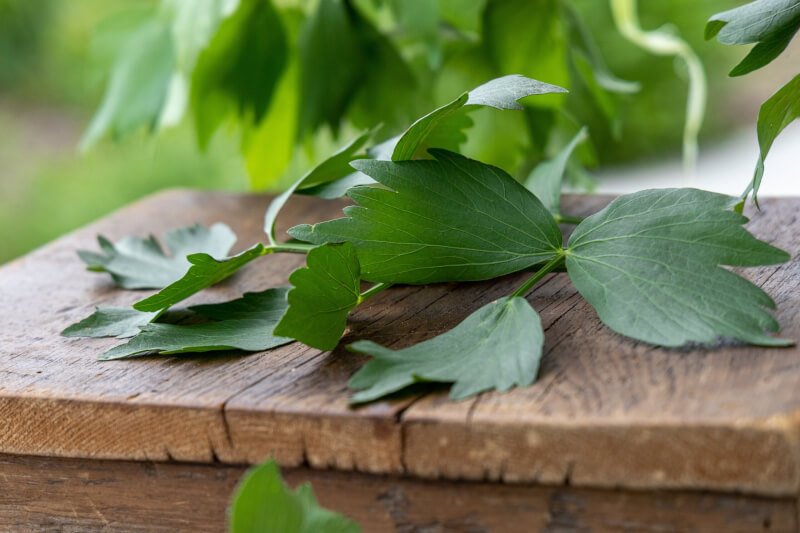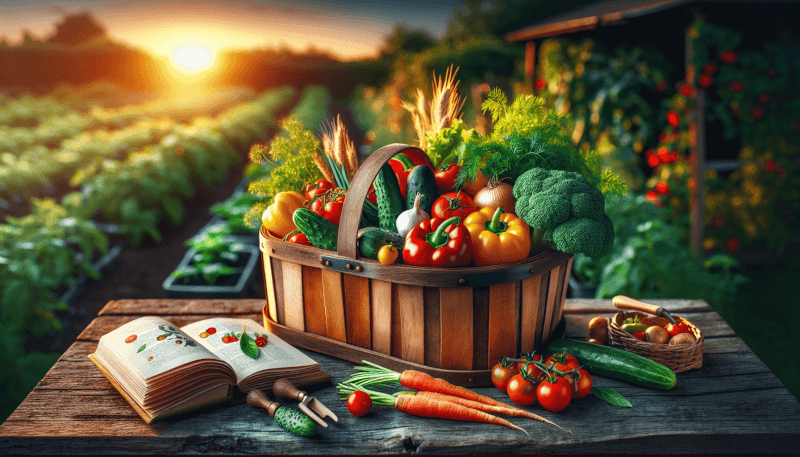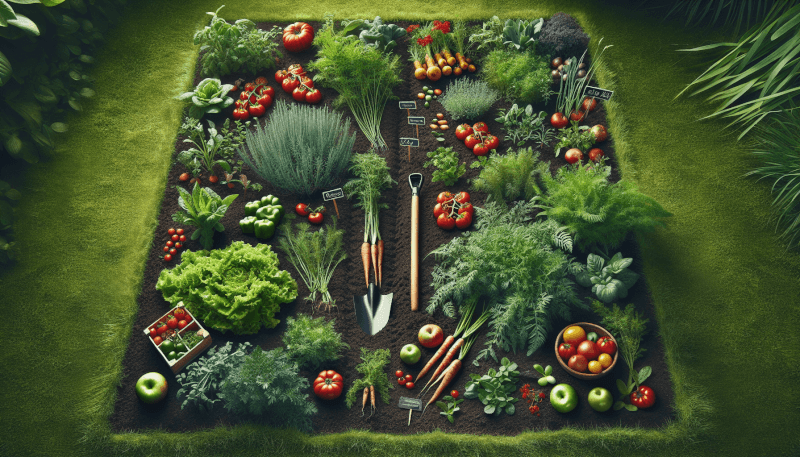Imagine having access to fresh and flavorful ingredients from your garden all year round, no matter the season. With a little planning and organization, you can turn this dream into a reality. In this article, you will discover the key steps to planning your garden for year-round recipe ingredients. From selecting the right plants to understanding the concept of succession planting, you will gain valuable insights on how to create a garden that can provide you with a bountiful harvest throughout the seasons. Get ready to take your culinary creations to the next level with homegrown goodness that never runs out.

Choose a Variety of Plants
When planning your garden, it’s essential to choose a variety of plants to ensure a diverse and plentiful harvest throughout the year. Consider the climate of your region and select plants that thrive in your specific conditions. Some plants are more tolerant of heat, while others prefer cooler temperatures. By understanding your climate, you can choose plants that will thrive and produce abundant crops.
In addition to considering climate, it’s essential to select plants with different growth rates. Some plants, such as lettuce and radishes, have a short growth cycle and are ready to harvest within weeks. Meanwhile, others, like tomatoes and peppers, have a longer growth cycle and require more time before they are ready for harvest. By including plants with different growth rates, you can enjoy a continuous supply of fresh produce throughout the year.
Another factor to consider when choosing plants is their harvesting season. Different plants have different seasons in which they produce their bountiful harvest. By selecting plants with different harvesting seasons, you can ensure a steady supply of fresh fruits and vegetables throughout the year. This way, you can enjoy the delights of your garden no matter the season.
Create a Garden Layout
To maximize the productivity and beauty of your garden, it’s essential to create a well-thought-out layout. Start by measuring your available space to determine how much room you have for planting. Consider the sunlight and shade patterns in your garden, as some plants thrive in full sun, while others prefer partial or full shade. By understanding the light conditions in your garden, you can allocate the appropriate space for each plant and ensure optimal growth.
Another crucial aspect of garden layout is grouping plants with similar watering needs together. Some plants require more water than others, and by grouping them together, you can ensure efficient irrigation. This way, you can avoid overwatering some plants while underwatering others. Allocating space for each plant based on its growth requirements is also crucial. Some plants, like sprawling squash vines, need more space to spread out, while others, like compact herbs, can be planted closer together. By planning and allocating space accordingly, you can create an organized and thriving garden.

Plan for Succession Planting
Succession planting is a technique used to ensure a continuous harvest throughout the growing season. To plan for succession planting, research the average harvest time for each plant you intend to grow. This will help you determine when to replant or sow new seeds for each crop. By staggering the planting times, you can ensure a constant supply of fresh produce without experiencing lulls or gaps in your harvest.
Prepare new seedlings or plants for continuous planting by starting them indoors or in a separate area of your garden while the previous batch is still growing. This way, as one crop is reaching its end, the new one is already in progress. Implementing succession planting enables you to make the most of your garden space and optimize productivity.
Implement Crop Rotation
Crop rotation is an essential practice for maintaining soil health and preventing the buildup of pests and diseases. To implement crop rotation, it’s crucial to understand the benefits it brings to your garden. By rotating plant families in different sections of your garden each year, you can break the life cycle of pests and diseases that may be specific to certain plants. Additionally, different plant families have varying nutrient requirements, and by rotating them, you allow the soil to replenish essential nutrients naturally.
To implement crop rotation effectively, divide your garden into different sections and assign a different plant family to each section each year. For example, if you grew tomatoes and peppers in one section this year, plant a different family, such as legumes or leafy greens, in that section next year. By practicing crop rotation, you can maintain a healthy and balanced garden ecosystem.

Consider Indoor Gardening
If you have limited outdoor space or live in an area with harsh weather conditions, indoor gardening can be a fantastic option. Before diving into indoor gardening, it’s crucial to evaluate your indoor space and lighting conditions. Look for areas in your home that receive ample sunlight, such as windowsills or rooms with south-facing windows. This will ensure that your indoor plants receive the natural light they need to thrive.
When it comes to indoor gardening, choosing suitable containers and potting mix is essential. Ensure that your containers have proper drainage to prevent waterlogged roots and select a high-quality potting mix that provides adequate moisture retention and nutrients for your plants. Additionally, be mindful of the size of the containers to accommodate the growth of your plants.
Selecting herbs and vegetables that thrive indoors is also crucial for successful indoor gardening. Herbs like basil, thyme, and mint are excellent choices for indoor cultivation, as they can thrive in pots and provide you with fresh flavors year-round. Leafy greens like lettuce and spinach also grow well indoors and can be a great addition to your indoor garden. With proper care and attention, you can enjoy the benefits of indoor gardening and have a source of fresh produce right in your home.
Maintain Proper Soil Health
Healthy soil is the foundation of a thriving garden. To ensure proper soil health, it’s essential to conduct a soil test before planting. A soil test will provide valuable information about the nutrient levels and pH balance of your soil. Based on the test results, you can make informed decisions about amending the soil with organic matter or additives to improve its fertility.
Amending the soil with organic matter, such as compost or well-rotted manure, helps improve its structure, moisture retention, and nutrient content. Adding organic matter also enhances beneficial microbial activity in the soil, creating a healthy ecosystem for your plants. Additionally, applying appropriate fertilizers and nutrients based on your soil test results will help meet the specific requirements of your plants.
Regular weeding and mulching are essential for maintaining proper soil health. Weeds compete with your plants for nutrients and water, so removing them regularly is crucial. Mulching not only helps suppress weeds but also helps retain moisture in the soil, regulates soil temperature, and adds organic matter as it breaks down. By practicing regular weeding and mulching, you can keep your soil healthy and provide optimal conditions for plant growth.

Provide Adequate Watering
Proper watering is vital for the health and growth of your plants. To provide adequate water, determine the specific water requirements of each plant in your garden. Some plants, like tomatoes and cucumbers, require more water, while others, like succulents or drought-tolerant herbs, require less frequent watering. By understanding the water needs of each plant, you can prevent under or overwatering, which can lead to plant stress or diseases.
Installing an efficient watering system can help you save time and ensure that your plants receive the right amount of water. Drip irrigation or soaker hoses are excellent options for providing targeted and efficient watering to your plants. These systems deliver water directly to the roots, reducing water waste and minimizing the risk of fungal diseases caused by wet foliage.
Monitoring soil moisture levels regularly is essential to ensure that your plants receive adequate hydration. Stick your finger into the soil about an inch deep and check for moisture. If it feels dry, it’s time to water. By providing consistent and appropriate watering, you can promote healthy plant growth and maximize your garden’s productivity.
Control Pests and Diseases
Pests and diseases can wreak havoc on your garden if left unchecked. To maintain a healthy garden, it’s crucial to identify common pests and diseases in your region. Research and educate yourself about the signs and symptoms of prevalent pests and diseases in your area. This knowledge will help you identify potential issues early and take prompt action.
Implementing preventive measures like companion planting can help deter pests naturally. Some plants naturally repel pests or attract beneficial insects that prey on pests. For example, planting marigolds alongside your vegetables can help repel pests like nematodes. Basil, on the other hand, can attract beneficial insects like bees and butterflies.
When dealing with pests or diseases, it’s best to use organic pest control methods whenever possible. These methods are environmentally friendly and safe for beneficial insects and pollinators. Options include using insecticidal soaps, neem oil, or homemade organic sprays. Remember to monitor your plants regularly and take action at the first sign of trouble to prevent the spread of pests and diseases.

Harvest and Preserve Your Produce
The ultimate reward of gardening is the bountiful harvest. To make the most of your garden’s produce, it’s crucial to determine the ideal time to harvest each crop. Harvesting too early or too late can impact the flavor and quality of your vegetables and herbs. Research the specific harvest times for each plant, and pay attention to visual cues like color and size to determine when it’s time to pick.
Implement proper harvesting techniques to avoid damaging your plants and ensure optimal flavor and shelf life. Use sharp and clean tools, such as scissors or pruners, to make clean cuts and minimize damage. Harvest leafy greens by picking outer leaves and allowing the inner ones to continue growing. For fruits like tomatoes or peppers, gently twist or cut them from the plant with a short stem attached.
Once you’ve harvested your produce, explore various preservation methods to enjoy it year-round. Canning, freezing, and drying are popular techniques for preserving fruits, vegetables, and herbs. Canning involves sealing produce inside jars along with a preserving liquid, while freezing requires blanching and freezing in airtight containers. Drying involves removing moisture from your produce to extend its shelf life. By preserving your harvest, you can savor the flavors of your garden throughout the seasons.
Keep Learning and Experimenting
Gardening is a journey of continual learning and experimentation. To expand your knowledge and refine your skills, read gardening books and resources. These provide valuable insights on various aspects of gardening, from plant care to seasonality. Join gardening communities and forums to connect with fellow gardeners and gain inspiration from their experiences. Sharing tips and advice with other gardeners can be invaluable in enhancing your gardening skills.
Trying new plant varieties and growing techniques can add excitement and diversity to your garden. Experimenting with unique or heirloom plant varieties can introduce new flavors and colors to your table. Similarly, exploring different growing techniques, such as vertical gardening or hydroponics, can expand your gardening possibilities and maximize your space and yields.
Keeping a garden journal is a wonderful way to track your progress, document your successes and challenges, and reflect on your gardening journey. Record planting dates, harvest times, and any observations or lessons learned. Your garden journal serves as a valuable reference for future seasons and can help you make informed decisions based on your past experiences.
In conclusion, planning a garden for year-round recipe ingredients involves several key considerations. By choosing a variety of plants, creating a well-thought-out garden layout, implementing succession planting and crop rotation, considering indoor gardening, maintaining proper soil health, providing adequate watering, controlling pests and diseases, harvesting and preserving your produce, and continuing to learn and experiment, you can create a thriving and sustainable garden that provides you with fresh ingredients throughout the year. So roll up your sleeves, put on your gardening gloves, and get ready to enjoy the joys of gardening and the delicious rewards it brings to your kitchen. Happy gardening!

